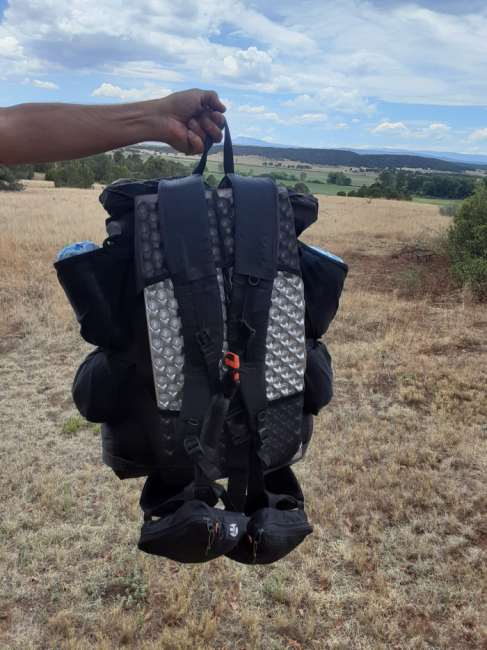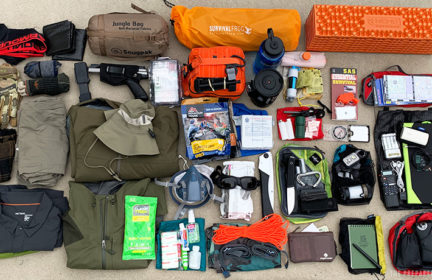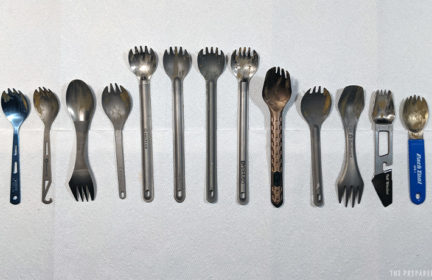An introduction to lightweight backpacking
An Introduction to Lightweight Backpacking
Greetings everyone here at The Prepared. I have been asked to write out my thoughts on lightweight backpacking and how it can play a part in helping people get through the very difficult conditions we may have to face in the near future.
This essay is not intended to be a hiker vs prepper series of arguments. Hikers have a distinctively different outlook than preppers. However, backpacking gear comes from the same desire to survive and thrive in a hostile world. Hikers and preppers can learn a lot from one another. This essay is intended to open a path between our communities so that both may benefit.
Some Principles of Backpack Weight Reduction
1) The heaviest thing we carry on our backs is fear.
Write down what you fear.
Learn how to overcome it.
2) Weigh everything.
List every item and record its weight.
If you do not use it, it is just a rock.
3) Reduce weight where possible.
Eliminate factory packaging.
Carry the least amount of non food consumables between resupplys.
Trim excess whatever as is possible without damaging a things integrity.
Can one item do multiple tasks?
Are lighter, equally useful substitutes available?
Can some pieces of equipment be shared among a committed couple or dependable group?
Are resources available in your environment which can be used, then discarded when done, so that there is no need to carry it around?
4) Properly distribute all weights
Pack in modular sets so that weights can be adjusted as needed to maintain balance: water bottles against your back, food bags in the middle, never let anything dangle off the packs exterior, gadgets in your belt pouches, trekking poles in your hands (not your pack).
5) The more you learn the less you need to carry or the more effective it is.
6) When useless weight has been eliminated, add weight back, as the situation requires, to ensure minimum safety and comfort under anticipated conditions.
Definitions
The following is mainly a presentation on what lightweight gear is and how to use it under normal wilderness trail conditions.
‘Lightweight’ is defined in the current sense of a base weight at about 20 pounds. This does not include what you wear on a normal day or carry in your hands. This also does not include the rapidly changing weights of fuel, water and food.
Over the years, gear weights have gotten ever lighter. It is now fairy easy to get pack, base weight down to about 10 pounds. Somewhere around this point is where the gear starts getting expensive but IMHO worth it.
There is no one single source of ‘got it all figured out’ book or web site which tells you everything you need to know about lightweight backpacking. There are, however, dozens of summaries from personal experience – such as this one – which are a useful starting point for the motivated individual.
Not Included Weight
Shoes and Walking
Very few people know how to walk (including experienced hikers) and most shoes cripple the feet. A way to learn how to walk properly is to buy whatever kinds of shoes and boots offered at thrift stores, experiment with various off the retail shelf socks and inserts then consciously walk as much as possible in them.
Once you have learned enough to have a conversation about feet, shoes and walking, locate a running shoe store operated by qualified personnel. They probably won’t care too much about SHTF scenarios but they will be interested in helping you to select a shoe suitable for extensive back country hiking.
Trekking Poles
Trekking poles are the human version of four wheel drive. The nominal pole height is with your forearms at 90 degrees to your body. Adjust as you feel is needed.
On flat land, the poles will become outriggers preventing ankle roll outs or serious stumbles from becoming injury delivering falls. On steep downhills the poles can be lengthened and now extended out in front as a kind of brake. This will take some stress off of your legs and back and prevent a downhill fall. When your arms are strong enough, the lengthened poles can be used to push yourself uphill.
Animals and predatory humans instinctively regard trekking poles as weapons, which they are. Tarps and one pound tents are possible because trekking poles are used to hold them up.
Wear Clothing
The clothing layers that are considered normal wear are the base layer or underwear and the shell or pants, shirt, hat and sunglasses on a lanyard around your neck.
Please take the time to do your own base layer research. Fully test out your choices by wearing them for days at a time. An inappropriate base layer will cause all sorts of problems.
The fabric of choice for the shell is nylon or a variety of synthetic blends. Synthetic fabrics are extremely light, dry fast and wear forever. Up until recently, safari shirts and kind of limited pocket cargo pants were the most popular choices on the trail. These are probably still good choices for preppers.
Two key requirements of a shirt is that it have full length sleeves and that there not be a stitched seam across the top of the shoulder. This goes for the base layer T shirt or sports bra as well. Such a seam at this location will cut into your shoulder under the weight of even a lightweight backpack. The pain comes on fast and will put a stop to your hike.
One very useful type of pants is the ‘convertible’. This allows the bottom of each leg to be unzipped to create temporary hiking shorts.
A reminder: Cotton Kills!
Rapidly Changing Weights
As previously mentioned, fuel, water and food are not counted against the base weight of the backpack because these weights change quickly and in practical terms are very difficult to measure. However, these obviously are weights which needs to be managed.
Fuel & Stove
If you do not need to cook your food you do not need a stove or its fuel. An upfront savings of 1 to 2 pounds.
Water
Water weighs 2.2 pounds per liter. Hikers generally favor the tall plastic bottles made by Lifewtr or smartwater. Both are about 1.4 ounces empty weight each. 1 quart Nalgene plastic bottles weigh about 6 ounces. Metal bottles tend towards Nalgene weights.
Food
A rule of thumb is that we can go without air for 3 minutes, without water for 3 days and without food for 30 days. The air and water estimates are highly controversial, but people can go without food for extended periods and generally are the better for having done so. The health improving effects of not eating are widely documented and even formalized in fasting disciplines.
Thru-hikers routinely, but inadvertently, practice a kind of fasting because the act of long distance hiking will burn more nutrition between re-supply points (usually measured in calories) than can be carried in a pack. The way we deal with this is to eat like starving coyotes while in town.
Historically, refugees have routinely had to travel hard with minimal food or no food at all. Preppers will have to deal with this in future SHTF scenarios. It would be interesting to hear a qualified nutritionist comment on how conscious fasting disciplines can be used to extend food supplies.
Actual hiker foods are normally straight off the grocery store shelves. Some hikers will cook, dry and vacuum package food then have someone send it to a re-supply point on the trail. Very few eat the freeze dried backpacker foods. No one eats MRE’s.
An understanding of food values is as important as an understanding of lightweight gear. Unfortunately, it is outside the scope of this presentation.
Food weights vary from one hiker to the next and one re-supply point to another. This is where lightweight backpacking really pays off: you can load up with as much food as you can get in your pack and still make big miles without crippling yourself.
The estimated load limit for my light weight backpack is about 35 pounds. As my total pack weight is about 13 pounds 9 ounces, that allows for about 19 pounds of food and 2 pounds, or one liter, of water. That is enough for 5 to 7 days of normal hiking. Rationing and/or fasting could potentially double that estimate. Water weight obviously varies daily and is replenished on the fly but as food weight decreases, water weight can increase. Water is an very important part of a fast.
Backpack Base Weight
This base weight presentation will be organized around my backpack and some of my personal gear selections. This is not an attempt to promote my gear choices or my favorite vendors. I do not financially benefit in any way or receive free gear. This is simply the outfit I know best and hope that a examination of it will serve as a departure point for others who wish to assemble their own lightweight backpack. Out on the trail there are almost no two packs alike as there are hundreds of ways to put one together. Just ask any gear head.
Pack Sack System, about 24 ounces
There is no need for built in compartments with zippers and excessive loops. There is no need for strong fabrics or heavy duty hip belt and shoulder strap harnesses either. I have an original Gossamer Gear ‘G4’, bought in 2010, now with 1300 miles of mountain hiking bushwhacking on it and its still good to go. It is just a big empty sack. With two belt pouches it weighs 20 ounces. Too bad its not made anymore. But you can make your own with a very low cost pattern from Quest Outfitters!
There are two easy to overlook sources of weight that properly belong to the pack sack category: pack cover and gear stuff sacks.
Pack covers are a pointless weight and a waste of money. They do not keep the surface next to your back dry so moisture leaks into the pack from there and the bottom of the cover collects water. Hikers have been experimenting with a variety of plastic bags used inside the pack as pack liners and stuff sacks. Current favorites are turkey roasting bags and the Clean Zipper brand zip lock bags (lighter and safer than ZipLoc). I use 5 dyneema fabric stuff sacks and a waterproof liner from Zpack. These weight just over 3.5 ounces.
Sleeping Bag system, about 48 ounces
The most common choices are goose down insulation in the 0 to 10 degree range. Do your research as you will get what you pay for. I threw down a kilobuck for a state of the art 10 degree bag that all but sings me to sleep. Weighs 37 ounces.
Like pack sacks, total sleeping bag weight includes two other pieces of gear: the ground sheet and the ground pad.
A 6×4 foot (or so) piece of black Tyvek can be bought from picture frame shops or online and is a good choice for the ground sheet. It weighs about 4.5 ounces. The same size piece of clear plastic Polycryo from Gossamer Gear weighs 1.8 ounces and is claimed to be tougher than Tyvek.
The Thermorest Z-lite pad is an all around good choice. I cut off 4 of the sections to make a ¾ length pad which dropped the weight from 13 ounces to 9.2 ounces. Two reasons: A) the G4 backpack uses the Z-lite as the frame. You will have to study the pattern from Quest Outfitters to see why. Anyway, 14 sections make too thick of a frame. 10 sections is perfect, B) when the ¾ pad is laid out for sleeping, you can put the empty pack sack under your feet for a full length ground pad insulating effect.
Tent, about 33 ounces
Free standing tents are more popular than tarps and bivvy bags because tents can more easily handle a wider variation of weather conditions as well as provide privacy in public areas like campgrounds. The tent will add several degrees of heat capture even without direct solar gain. 2 person tents for single person will also allow for room to wait out a multi day storm without going stir crazy.
Tents of any kind, as well as tarps and bivvys, need to be carried in waterproof stuff sacks because they are usually wet from overnight dew or rain.
I transferred the tent stake weight to my one of my trekking poles.
Note: The rain poncho and the bivvy always seem like good light weight gear choices but in practice they never work out very well. The poncho is simply not big enough and the bivvy becomes a sauna on a warm, skeeter filled night because it cannot be opened. I have always wondered if these technologies could be improved. If so, the weight reduction would be on the order of several pounds. The light weight backpacking community has pretty much abandoned both of them. Perhaps gear heads in the prepper community would be interested to keep exploring this weight reduction opportunity.
Carry Clothing, about 55 ounces
The insulating layer is quite important as is easy to imagine. What usually gets overlooked is that hiking burns calories which heats the body. Too warm of an insulating layer gets the body too hot while hiking and thus is pointlessly heavy to carry.
The most common list is: insulated bottoms & tops (which double as pajamas and increase the heat capture of the sleeping bag) Second pair of socks. Possible second pair of shorts. Dedicated sleeping socks. Skull cap & balaclava. Weather resistant gloves. And zip lock bags which are carried to isolate dirty socks.
The same problem of overheating applies to the weather shell, usually a goose down puffy under a rain jacket. But there is an important additional problem; body heat also generates sweat which can be captured by the rain jacket. Unless vented, this can lead to soaking wet clothing then to chaffing or hypothermia.
One solution is to wear a vest, made of synthetic material, under the rain jacket and keep flapping air between the several layers. The other is to buy a crazy expensive rain jacket at the hardshell level which will vent out the sweat without letting the rain in.
Water Containers, About 5.5 ounces
A noted earlier, tall skinny smartwater bottles weigh 1.4 ounces each. I prefer to carry 2 Platypus 2 liter bags at 1.6 ounces each with the drinking tube attachment at 2.2 ounces. These are BPA free and work very well with the Sawyer inline filtration system.
Water Filtration, about 6.5 ounces.
Micro Squeeze Sawyer filter, its misc parts and the A/B containers of Aquamira chemical disinfectant. The Micro Sawyer works with the smartwater and platypus containers but not with any other water container that I know of.
Food Containers & Utensils, about 4 ounces
Food containers are a bit of a wild card. The normal container is a couple of simple stuff sacks or even heavy duty plastic grocery bags. For no-stovers, add a P38 can opener and titanium spork for about 2.5 ounces.
In some areas, bear cans, Ursacks or hanging your food bags from trees are advisable or required. As bear cans and a two Ursacks are in the pound range, hanging food bags is the preferred option. I made a food hanging kit from the little stuff sack that the tent stakes came in and a length of macrame cord. Weighs about 1.5 ounces.
Medical / Hygiene / Repair / Misc Kits, about 7 ounces
Note: There is a truism on the trail that the bigger the medical kit the less likely the hiker knows how to use it. With any luck this is not true of preppers. However, your recommended medical kits look like they could stand to be measured against the Principles of Backpack Weight Reduction and still be as effective as you intend them to be.
Medical: 2 Neosporin goop packets, one with tic fork in it. Two band-aids. 20 Advil tablets. 6 electrolyte tablets. Not counted weight is duct tape and muscle tape attached to one of my trekking poles.
Another Note: It is also a truism that very few hikers know anything about wilderness first aid regardless of med kit size. Our guiding philosophy is: ‘Don’t Get Hurt!’. Granted, not a very good one, but injuries are quite rare.
Hygiene: (it is unethical to use soap in the backcountry) 2 ounce spray bottle full of 70% rubbing alcohol and dedicated handkerchief for daily cleaning of feet and smelly bits. 1 toothbrush with handle cut down (to get it inside a plastic bag) 6 dental floss toothpick things. Plus a plastic comb.
Repair: 20 feet of polyester thread wrapped around a plastic thing I found with a sewing needle stuck through it.
Misc: mini lighter in tiny plastic bag with vitamin bottle absorbent pouch and small piece of cardboard soaked in candle wax for fire starter. A KN95 face mask and two sets of soft ear plugs.
Poop Kit, about 6 ounces
In a small stuff sack are a half roll of toilet paper, a 2 fl oz squeeze bottle of hand sanitizer gel and The Deuce cat hole digging tool. In addition are 4, one quart zip lock bags for areas where packing out your toilet paper is required.
The Bat Belt, about 32 ounces
More and more hikers are attaching little pouches to their hip belt and shoulder straps. Photographers often have a not so small camera bag hanging off of their sternum and shoulder straps.
If done correctly, this throws weight forward and down in a kind of counter balance to the loaded backpack weight without interfering with the back and forth movement of trekking pole swinging arms.
Here is what I carry:
100% Deet skeeter juice.
Skeeter hat net
Petzl Zipka headlamp (eliminates the bulky head harness)
Reading glasses
3 AAA & 2 AA batteries in a plastic case
Garmin Oregon 450 stand alone GPS (uses 2aa batteries)
Small cell phone
BTECH UV-5X3 handy talkie (do not have ham license yet)
Opinel folding knife (can sharpen on a river rock)
BASUNE slingshot (never runs out of bullets)
Some of this stuff is a new addition to my regular outfit and I am struggling with how to incorporate it. Given the list of hardware that preppers like to carry around, the Bat Belt seems like a backpacking technology that your community would be motivated to advance. I am very interested in any in any suggestions or innovations that you come up with.
Happy Trails!
Chance
-
Comments (21)
-




